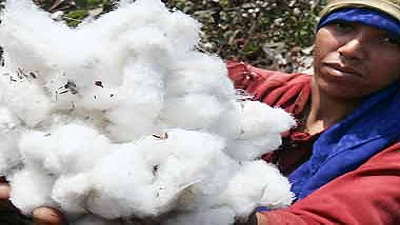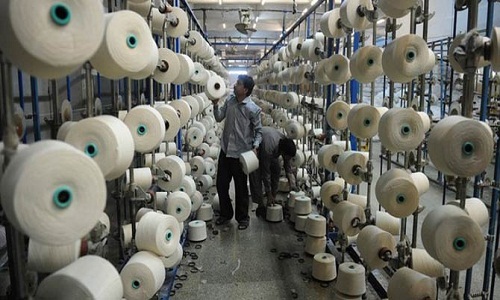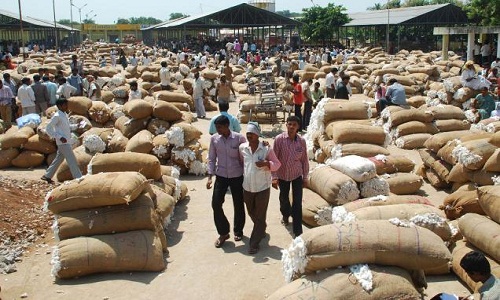FW
After Vietnam joined the World Trade Organization (WTO), its textile and garment industry has emerged with many opportunities to access technology, information and services as well as better management practices and equality of tariffs between member countries. With its own advantages, such as political stability, productivity, low labour costs, diversity of garments, Vietnam’s textile industry has increasingly gained reputation in the world market.
A study of the Organization for the Promotion of Exports from developing countries to the EU (CBI) under the Ministry of Foreign Affairs of the Netherlands revealed that the growth rate of textile exports from 2005 to 2011 in Vietnam reached the world’s highest with 32 per cent, while China was 15 per cent, India 10 per cent, Turkey, Malaysia and Thailand reached 7 per cent.
According to information from enterprises of Vietnam Textile and Garment Group, orders for rest of the year is quite optimistic. Furthermore, after the TPP, the opportunity to increase the market share in export is wide open for Vietnam textile and garment industry.
Cambodia looks forward to investment from the European Union. The country wants firms and industries from the EU to buy rubber and rice from Cambodia since Cambodia need more markets for those products. The flow of investments from the EU to Cambodia is increasing, especially from the United Kingdom. As a less-developed country, Cambodia enjoys free export quotas and duties to EU markets under the ‘Everything But Arms’ initiative. The EU accounts for about 40 per cent of Cambodia’s total rice exports.
The EU is the biggest market for Cambodia’s milled rice exports. The EU in fact has been a good market for Cambodia’s agricultural products like milled rice and also garments and footwear. Bilateral trade between Cambodia and the EU reached more than three billion euros in 2014. Total direct investment from the EU to Cambodia between January and October 2015 was about 76 million dollars compared with 86 million dollars in 2014.
EU imports from Cambodia are dominated by transport equipment. EU exports to Cambodia are dominated by machinery, transport equipment and agricultural products. Cambodia is one of the 10 members of ASEAN. The countries as a group are the EU’s third largest trading partner after the United States and China.
EDANA, the international association representing the global nonwovens and related industries closed its third Outlook Asia Conference in Singapore recently. The two days of presentations from economists, product and technology specialists, a review of the challenges to the industry of managing the waste that comes from the end of life of products and the actions, EDANA and its member companies are taking to address these issues.
While opening the conference, Pierre Wiertz, General Manager of EDANA said that since the late 1990s, strong income growth in Asia has been transforming the global income distribution. EDANA is dedicated to providing forums like this to deliver our common objective to contribute to the sustainable growth of the global nonwoven hygiene and personal care products industries, he added.
Participants highlighted their delight at the event, especially with the growing representation and attendance of regional professionals. Additionally, the range and coverage of topics presented by speakers was regarded as a positive reflection on the state of the Asian Pacific region, recognising both opportunities for growth, and its responsibility not just to its consumers, but to our broader society. The conference attracted 155 delegates, and an audience representing companies from 23 countries, with more than 90 professionals from the Asia Pacific and Australia.
A resurgent textile industry in Kenya using locally grown cotton would have a beneficial effect along the entire value chain. It would also benefit the local dairy industry as the cotton seed would go into making cake for cows.
The solution would seem to lie in giving individual farmers the incentives to grow cotton together with their subsistence crops. This would include high-yielding seeds and other inputs on credit. Farmers would also need extension services by well-trained officers working on set targets.
Kenya is best advised to base its manufacturing plans on attracting local investors with foreigners coming to supplement these efforts. Ideally, the revived cotton growing and textile firms would create the base on which the expected foreign investors would build their factories to produce finished clothes for their global customers.
However, Kenya won’t benefit much if the main reason that attracts multinational investors is cheap labor. This would be particularly true for firms relocating from China because the workers there have begun demanding a living wage. Such firms would be mainly attracted by the cheap labor in Kenya and especially in Ethiopia which offers wages that are even lower than Kenya’s.
This attitude coupled with multinationals’ track record of avoiding payment of legitimate taxes in countries where they are making the bulk of their money means the host country is a net loser.
Punjab Agricultural University's (PAU) two-day Kisan Mela with the theme of 'Kheti Melain De Rang, Sudhre Beej, Machinery, Kitaban De Sang', is aimed at urging farmers to use improved seeds, make optimal use of farm machinery and read farm literature for technical guidance.
In his inaugural address, the chief guest, PAU vice-chancellor Baldev Singh Dhillon, appealed to farmers to not make use non-recommended cotton varieties and pesticides. Agro-chemicals should be used in the right amount and at the right time and right place, he advised. Expressing concern over water issues and changing climate, he urged farmers to diversify by growing alternate crops like maize, fruits, and vegetables.
The guest of honour, Counsel General of Canada in Chandigarh, Christopher Gibbins said that out of 12 lakh Indo-Canadians, 7 lakh are from Punjab and they are making immense contribution to Canadian agriculture. Gibbins added that they would like to expand their research programmes by venturing jointly with Punjab in dairy and fishery sectors, food-processing, farm mechanisation and climate change.
Pakistan wants to have stronger relations with Turkmenistan. Lack of direct cargo links, safe and direct land routes, knowledge of Pakistani products and visa facilitation are the main hindrances hampering trade growth between the two countries.
Efforts are being made to overcome these issues and strengthen trade by enhanced market access, trade promotion and facilitation. Bilateral trade between the two countries is $25 million.
Turkmenistan’s textile industry is being developed with a special focus on production of export quality products. Currently 80 per cent of the country’s textile products are exported. The country seeks Pakistani investment in various sectors to cash in on the opportunities that the emerging market presents since Pakistan has a complete chain of industries in the textile sector.
The two countries have decided to pay special attention to establishing air, road and rail links on a priority basis. Pakistan is keen to see Turkmenistan join the China-Pakistan Economic Corridor (CPEC) in order to promote linkages with the southern port of Gwadar and the Arabian Sea. The western route of CPEC would provide landlocked countries of Central Asia the shortest trading route with east Asia.
CPEC has been compared in significance to the great trade route discoveries of the world.
Pakistan and Turkey will soon sign a free trade agreement. This will bolster trade between the two countries. It could spur joint ventures as, besides increasing trade, it would help lower the current high customs duties between the two sides.
The two countries have very close cooperation in diverse fields including defence and fighting war against terrorism and extremism. Current trade between the two countries stands at $600 million, but after signing the agreement it has the potential to touch the two billion dollar mark. Pakistan mainly imports telecommunication equipment, TV, cameras, radar apparatus, textile and machinery, while Turkey’s imports from Pakistan include textile yarn, cotton, woven fabrics, apparel and clothing accessories, plastics and organic chemicals.
Pakistan and Turkey have been negotiating the FTA for quite some time. Current Pakistani exports to Turkey are concentrated in a limited number of products as compared to Turkey, whose exports to Pakistan are much diversified. Though Pakistan currently has a trade surplus with Turkey, yet this can change quickly owing to Turkey’s wider range of product offerings.
Turkey is known to liberally use anti-dumping laws. It has already initiated anti-dumping cases on major Pakistani exports in the past.
The Taiwanese textile industry is doing extremely well as far as manufacturing technological and environmentally-friendly products is concerned. Most major Taiwanese companies are vertically integrated so that absolute control of the entire production process can be achieved to ensure that production is sustainable across all links of the chain.
Functionality and sustainability are today inextricably rooted in the DNA of Taiwan’s textile production chain, whether in terms of raw materials, manufacturing, processes, technology, product or the work environment.
There is a relentless pursuit for developing green textiles by melding functional and aesthetic fashion innovations to eco-friendly production. The aim is to improve consumers’ lives, in addition to contributing to preserving the environment. Based on polymer engineering and science, research and development activities focus on key technologies of engineering plastics, fiber techniques and high added value to textured yarns.
Taiwan’s textile manufacturers are surfing the wave by catering to the wellness generation, getting the production more cost-effective and going greener. New Copolymer is completely different from all materials existing in the market. It is not processed or added to the yarn or mixed with any other material. It is a new polyester that can be created or recycled. It is 100 per cent eco-friendly and end-to-end in the chain and the life cycle.
The Indian warp knitting industry is scattered in different pockets like Mumbai, Surat, Delhi, Ludhiana and Amritsar mainly producing two- and three-bar tricot fabrics. The main application areas are women’s dress material and saris, lingerie and outerwear, furnishing fabrics, shoe fabrics, automotive fabrics, agro textiles and interlinings.
Demand for warp knitting machines continued to grow due to the huge consumption for warp knitted fabrics in the domestic market. Warp knitting is by far the most versatile and a high productive fabric production system in the textile industry. Although this industry has been present in India for many decades, it is not widely known or popular like other fabric forming processes such as weaving and circular knitting.
Warp knitted fabrics can be produced in various structures such as rigid and elastic, open or closely knit structures, in flat or tubular or also in three dimensional form. The fabric widths can go up to 6.6 meters or even in multiple of this width if it is a net structure.
Warp knitting machines are mainly classified in two sections or groups – Tricot and Raschel. Basic knitting elements on the Tricot machines are guides, needle, tongues and compound sinker and those on the Raschel machines are guides, needles, tongues, stitch comb bar and knock over comb or trick plate.
"Domestic production in Pakistan and Bangladesh will not be able to keep pace with the increasing demand for apparels in these two countries, providing opportunities for Indian exporters. Quality will be the most important factor apart from the rupee’s value for India’s exports as other countries like Australia, Uzbekistan and Turkey will also be selling to Vietnam, Pakistan and Bangladesh."

Despite China’s significant reduction inimports and moderate demand from the Indian spinning industry, yarn prices are likely to remain at the current level. However, Indian and Pakistani players are worried. The cotton sector outlook released recently by India Ratings and Research (Ind-Ra), had said cotton sector is likely to revive moderately in 2016-17 season (August-July) as exports to Vietnam, Pakistan and Bangladesh may be higher than a year ago. Vietnam is likely to increase its spindles capacity by 30 per cent in FY16-17.

Domestic production in Pakistan and Bangladesh will not be able to keep pace with the increasing demand for apparels in these two countries, providing opportunities for Indian exporters. Quality will be the most important factor apart from the rupee’s value for India’s exports as other countries like Australia, Uzbekistan and Turkey will also be selling to Vietnam, Pakistan and Bangladesh.
Meanwhile, in April, China’s new policy is going to be announced that is critical to global trade dynamics and perceived pricing has put a lot of downward pressure on yarn prices. Speculation is rife that initially it will increase prices and gradually it should plummet beyond the initial phase.
At the just concluded Yarn Expo being held simultaneously with Intertextile Shanghai global yarn manufactures put their perspective on yarn pricing.
Higher tariffs, lower prices a dampener

JP Jain, VP-Marketing, TT, an exhibitor at Yarn Expo believes in short run price is likely to go down “Buyers, especially traders are inactive and holding their breath as Chinese cotton policy is expected soon and it could be a game changer for global trade dynamics. Hence, Chinese buyers are asking for lower prices such that Indian spinners have already reached a flash point, losing anything between Rs 10-12 per kg.”He feels, the China’s cotton policy will bring down already distressed prices. However, China will continue to remain a big factor especially for India, since China continues to import anything between 30 to 40 per cent of cotton yarn. If China keeps buying, it will add stability to supply demand dynamics. “Also there is a new development where many are shifting to compact yarn instead of normal.Moreover, stop gap exports to Pakistan through Wagah border has given a fillip to north Indian exporters, especially those in above 24s count. For above 24s count, good opportunities are emerging in Uzbekistan, Indonesia and Vietnam etc.”
UjwalLahoti, Vice Chairman, Texprocil feels, Indian exporters are losing out because of tariff which is 8-10 per cent more than neighbouring countries, while they pay zero tax. “Pakistan exporters for example, have factually higher cost of production compared to us. Yet they end up doing better because of favorable tariff structure. Trade balance between India and China is in favour of China.”He says,Texprocil has already flagged the issue to government. “At APTA (Asia Pacific Trade Association) level many recommendations have been made and government is tryingto get at least 50 per cent concession in existing levelsfor a level playing field. Indian government will also need to push it to China for 10 ‘HS Code lines’ to APTA for reduction.”
Texprocil’s ED Siddhartha Rajagopal, says they are making a strong pitch for better market access to fibre exporters and attract higher investment and generate more job opportunities. Also the industry needs to go for value addition taking a cognizance of the fact that China is losing competitiveness. “In 5-10 years, Indian industry needs to ramp up to close in the competition gap. It’s where initiatives like ‘Make In India’ can support,” he added.Meanwhile India needs to create a conduciveenvironment for building capacity and seize market share. Tirupur has created maximum number of jobs lately across sectors validating the immense potential this sector offers.
Pakistan too on thin ground
Rizwan Khan, MD-Gul Ahmed points out it’s an undeclared global recession and the world has to emerge from this situation. “Moreover, China’s focus on domestic market is discouraging yarn imports leading to falling cotton prices. The new Chinese cotton policy can only add fuel to fire as it is likely to use stocks and reserves of 2010-2011 onward. And since China consumes 50 per cent of global cotton it will create a ripple effect globally.”
Khan,feels factors such as local sales, flagging, exports, challenges and excess supply will have a catastrophic impacton Pakistan’s yarn sector. “The answer to the situation is value addition for Pakistan in dyed yarns, dyed yarn fabrics, garmenting, home furnishing as well as diversification to non-traditional markets etc. Also, there is a great dissension amongst Pakistan industry due to the imports deluge which is killing domestic industry. Oflate, Bangladesh has taken business away from Pakistan in knitting. Besides, raw grey yarn sale is deeply disturbed in Pakistan,” he summed up.












